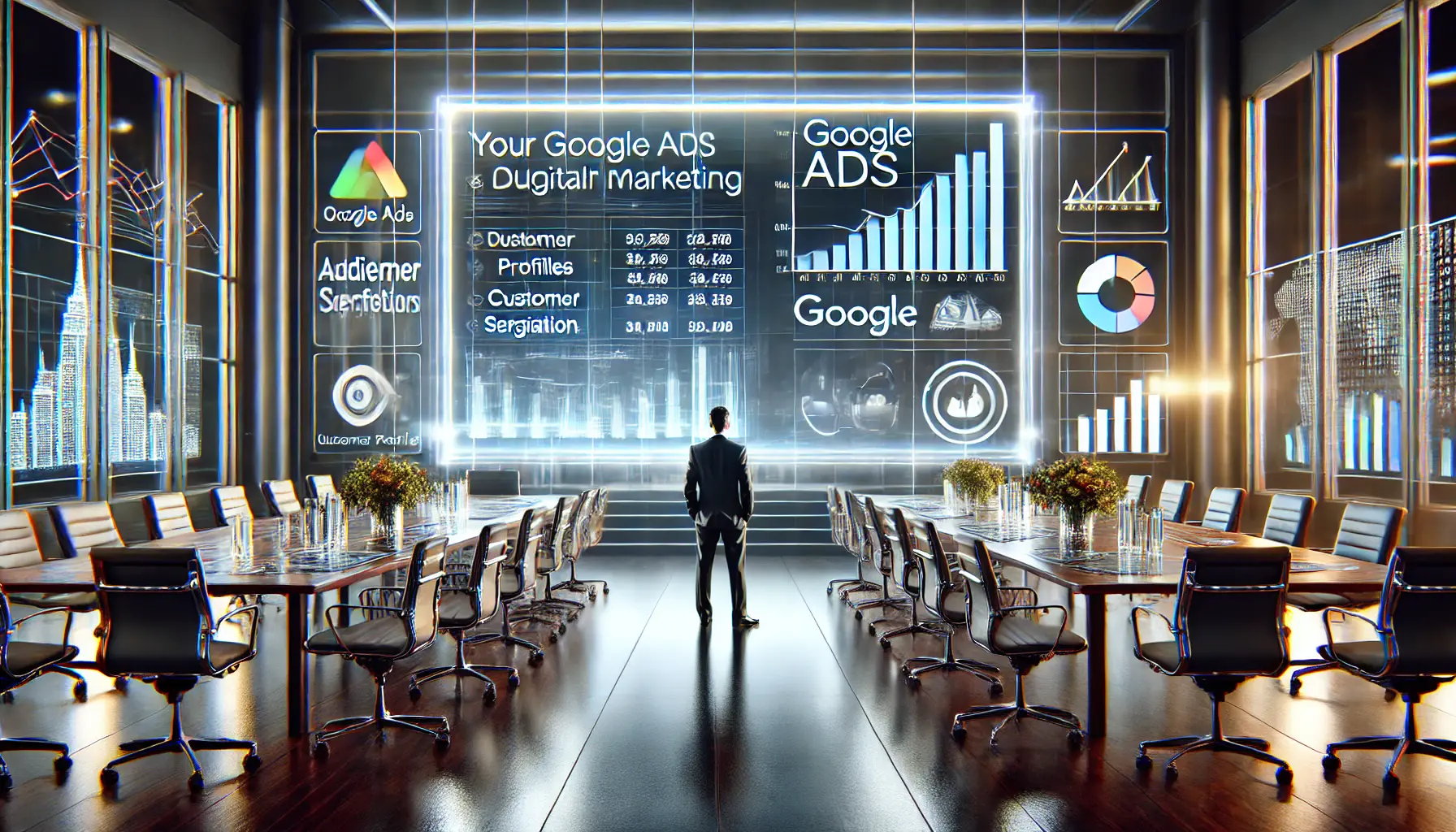In the field of digital marketing, it is very tough to stand out in an overly crowded online space.
It is here that Google Display Ads come into play, enabling the delivery of engaging visual content across millions of websites.
This makes it a powerful option for businesses trying to reach their target audience and improve brand visibility.
Whether you’re looking to increase conversions, build brand awareness, or re-engage previous visitors, understanding how Google Display Ads work is crucial for any successful marketing strategy.
In this article, we go in-depth with Google Display Ads, from their benefits to best practices for optimizing campaigns.
Let’s start by unraveling the basics and understanding why these ads are an essential part of any marketer’s toolkit.
- Understanding Google Display Ads: A Comprehensive Guide
- Setting Up a Successful Google Display Ads Campaign
- How to Maximize ROI with Google Display Ads
- Common Mistakes to Avoid in Google Display Ads
- Measuring and Optimizing Performance of Google Display Ads
- Mastering Success with Google Display Ads
- Frequently Asked Questions About Google Display Ads
Understanding Google Display Ads: A Comprehensive Guide
Google Display Ads are a cornerstone of online advertising, offering businesses the opportunity to showcase their products and services to potential customers in a visually appealing format.
These ads appear on the Google Display Network, which consists of over two million websites, apps, and videos.
With such extensive reach, they are an excellent tool for businesses looking to connect with a wide audience.
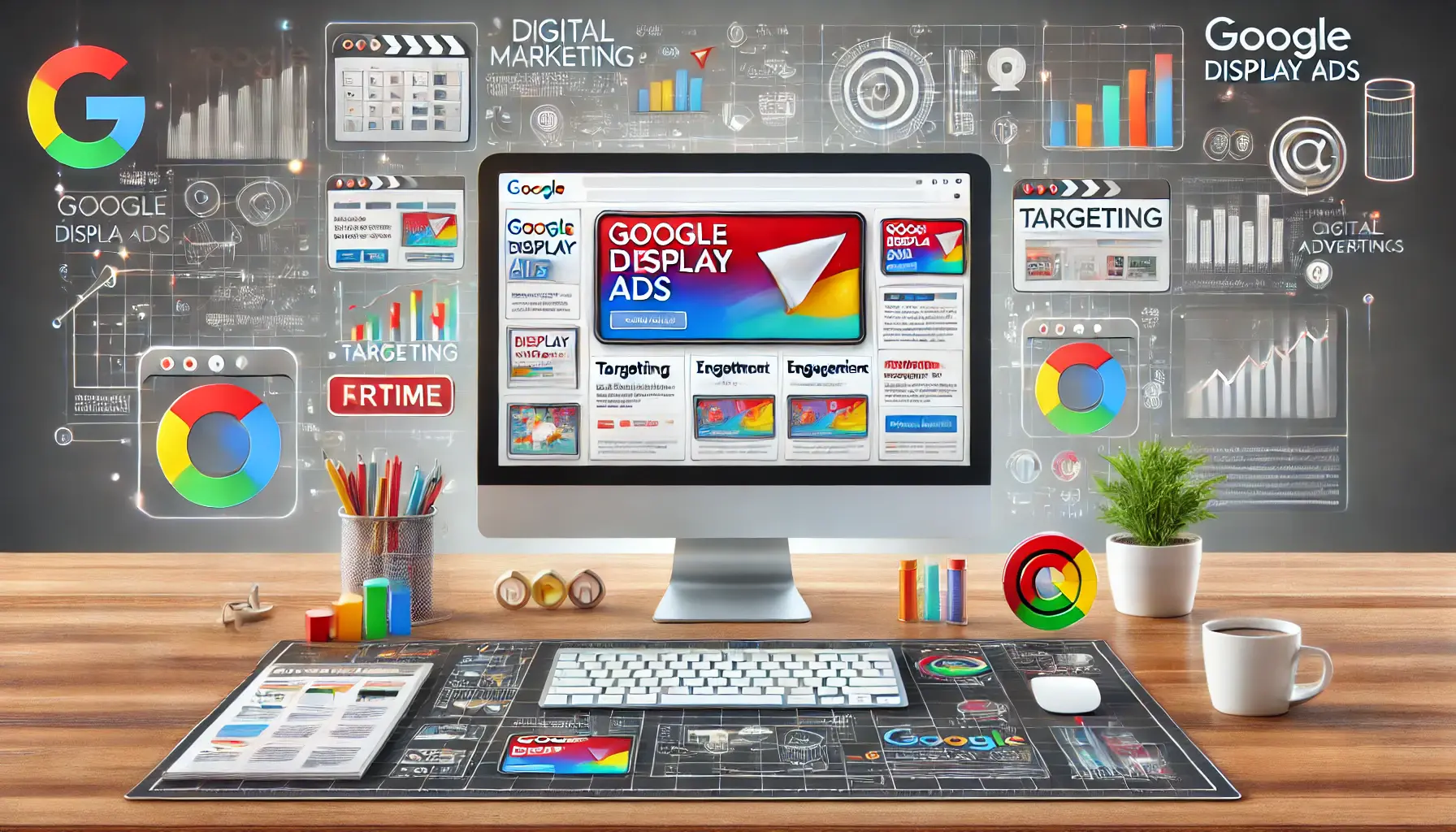
A representation of Google Display Ads, showcasing online ad placements and analytics in a professional workspace.
What Are Google Display Ads?
Google Display Ads are a form of online advertising that uses images, videos, or rich media to capture attention and communicate a brand’s message.
Unlike search ads that target users actively searching for a specific product or service, display ads focus on creating awareness and generating interest among users who might not be actively looking for your offerings.
- They are ideal for showcasing products visually, making them perfect for businesses in retail, fashion, or other visually-driven industries.
- Display ads allow advertisers to include eye-catching elements like animations, videos, and high-quality graphics.
- They work seamlessly across devices, ensuring a consistent user experience.
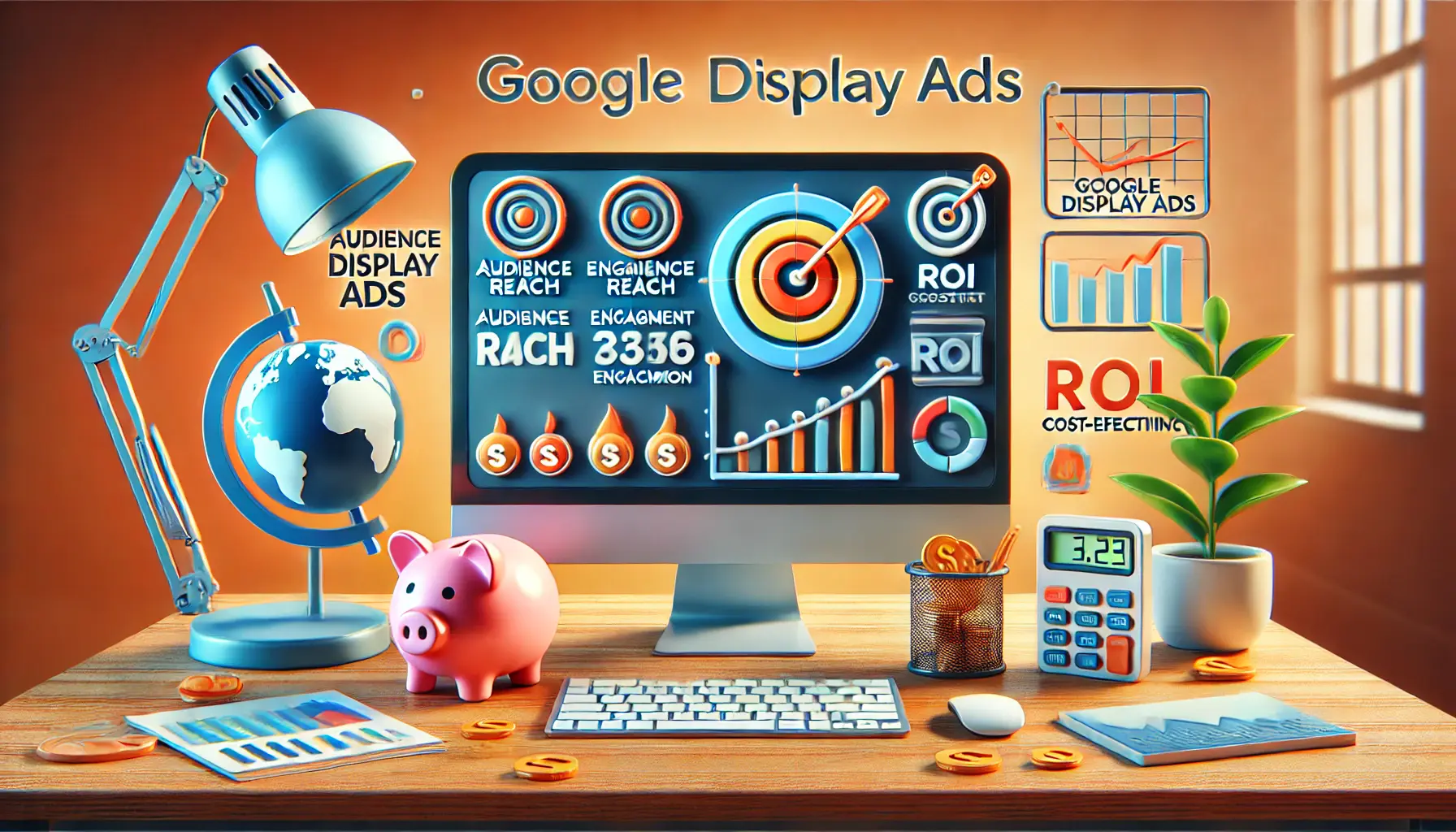
An illustration of the key benefits of Google Display Ads, emphasizing reach, precision targeting, and cost-effectiveness.
Key Benefits of Google Display Ads for Businesses
Google Display Ads offer several advantages that make them indispensable for modern marketing campaigns:
- Wide Reach: With access to millions of websites and apps, these ads can connect you with audiences globally or locally.
- Targeting Precision: Display Ads let you target users based on demographics, interests, and behaviors, ensuring your message reaches the right people.
- Cost-Effective: With flexible bidding strategies, you can control your budget and maximize return on investment (ROI).
- Brand Awareness: These ads help keep your brand top-of-mind for potential customers, even if they’re not ready to buy immediately.

An illustration depicting the mechanics of Google Display Ads, highlighting targeting, placements, and campaign setup.
How Google Display Ads Work
Google Display Ads operate through the Google Display Network, which uses advanced algorithms to match your ads with relevant audiences.
Here’s how this works:
- You design attractive ads with clear messages.
- You set up your targeting options, such as location, interests, and demographics.
- Google places your ads on websites, apps, or videos that align with the user’s preferences.
- Users engage with your ads, driving up engagement and conversions.
Knowing the core mechanics of how Google Display Ads work will empower you to make informed decisions about their role in your marketing strategy.
The following section will delve into how to create a successful campaign right from scratch.
Google Display Ads provide a visually engaging way to connect with audiences globally, making them a cornerstone of online advertising.
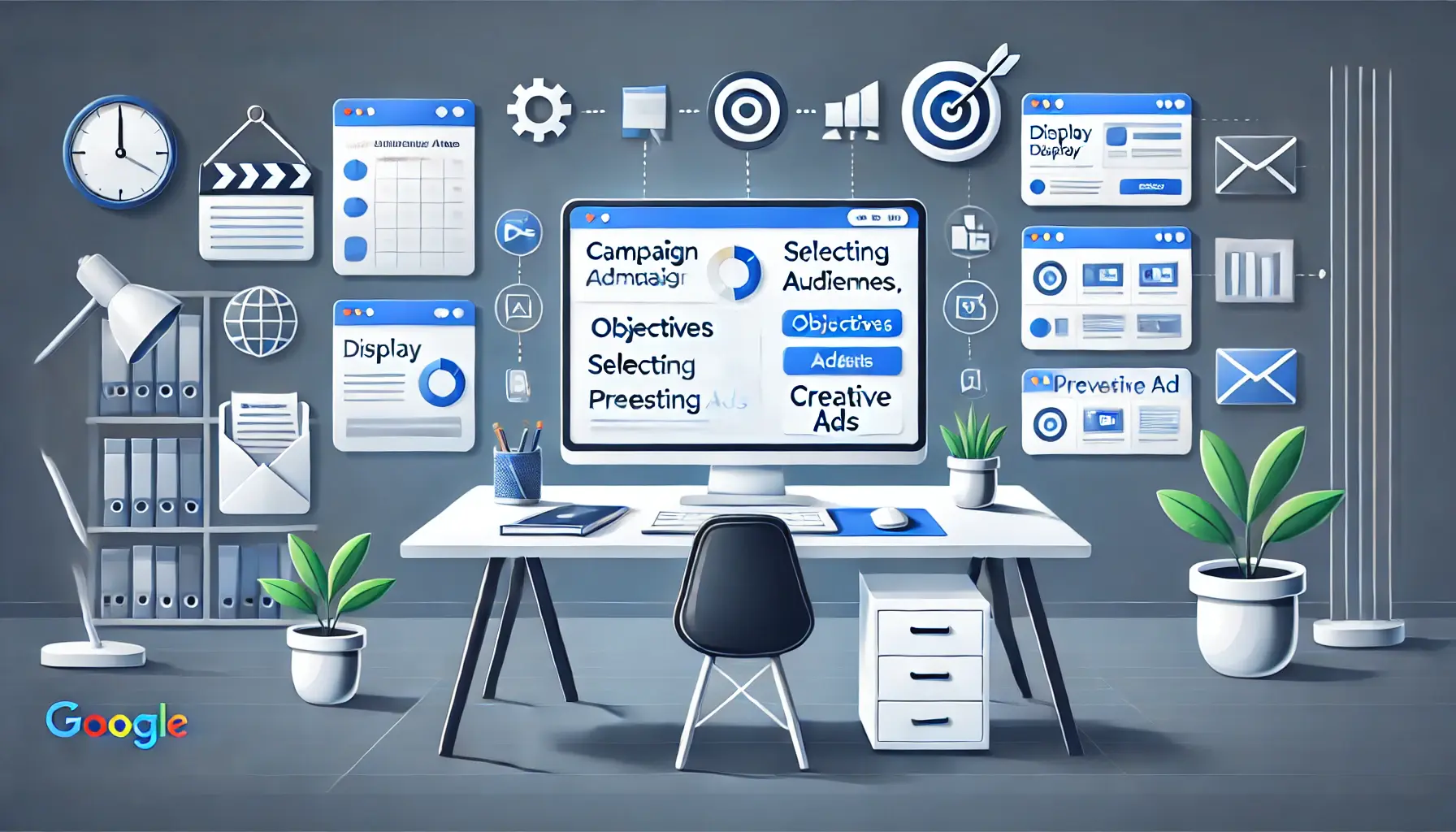
An image illustrating the process of setting up a Google Display Ads campaign with precision and organization.
Setting Up a Successful Google Display Ads Campaign
Creating a successful Google Display Ads campaign requires a well-planned strategy and attention to detail.
By understanding the setup process and using best practices, you can ensure your ads perform effectively and reach the right audience.
This section walks you through the essential steps to get started and optimize your campaign.
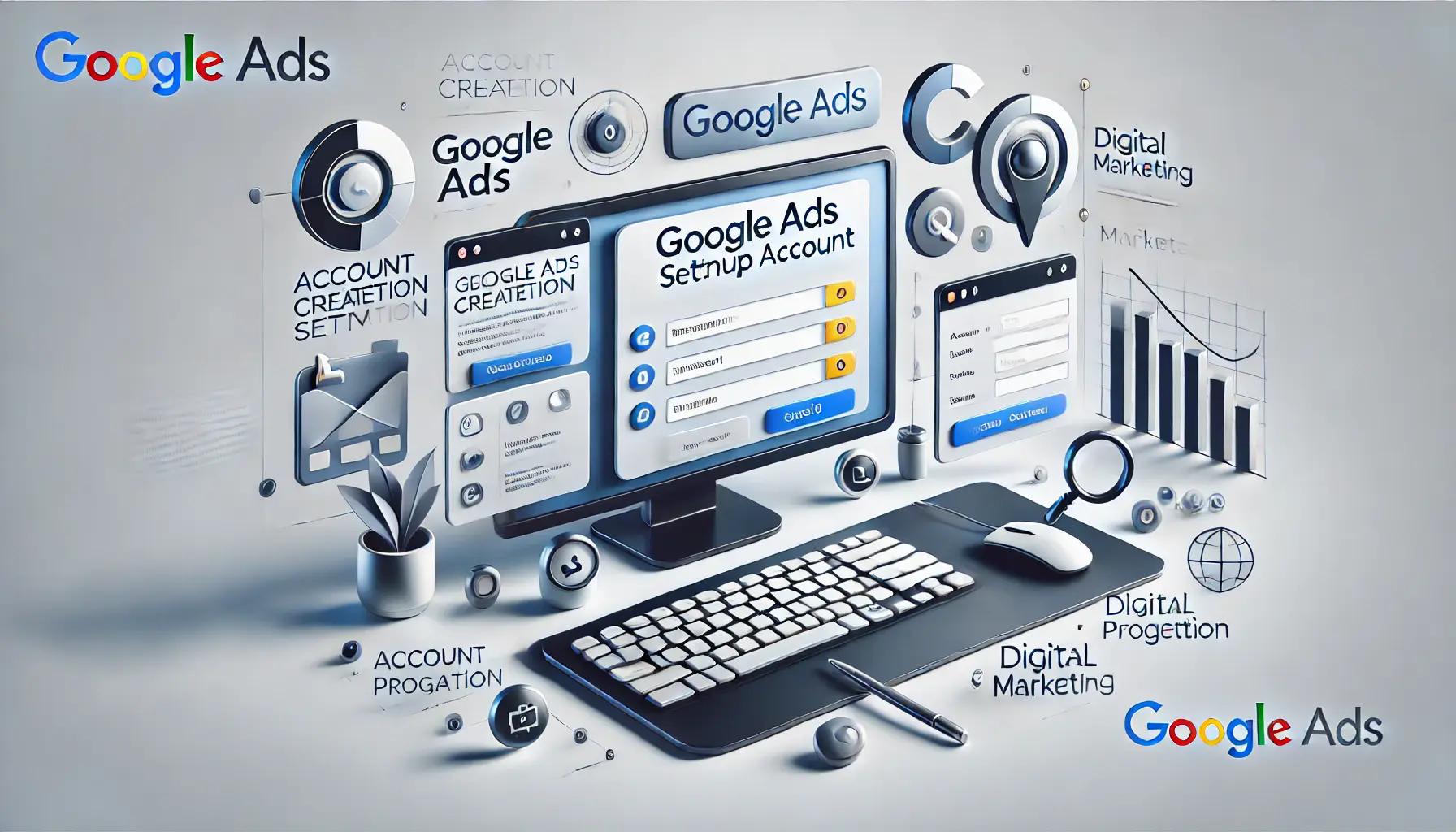
An image showcasing the process of creating a Google Ads account in a professional digital marketing setup.
Creating a Google Ads Account
The first step to launching a Google Display Ads campaign is creating a Google Ads account.
Follow these steps:
- Visit the Google Ads homepage and click on the ‘Start Now’ button.
- Sign in with your Google account or create a new one.
- Set up your billing information to activate the account.
- Choose the ‘Display Network’ option for your campaign type.
Once your account is active, you can start building your campaigns.
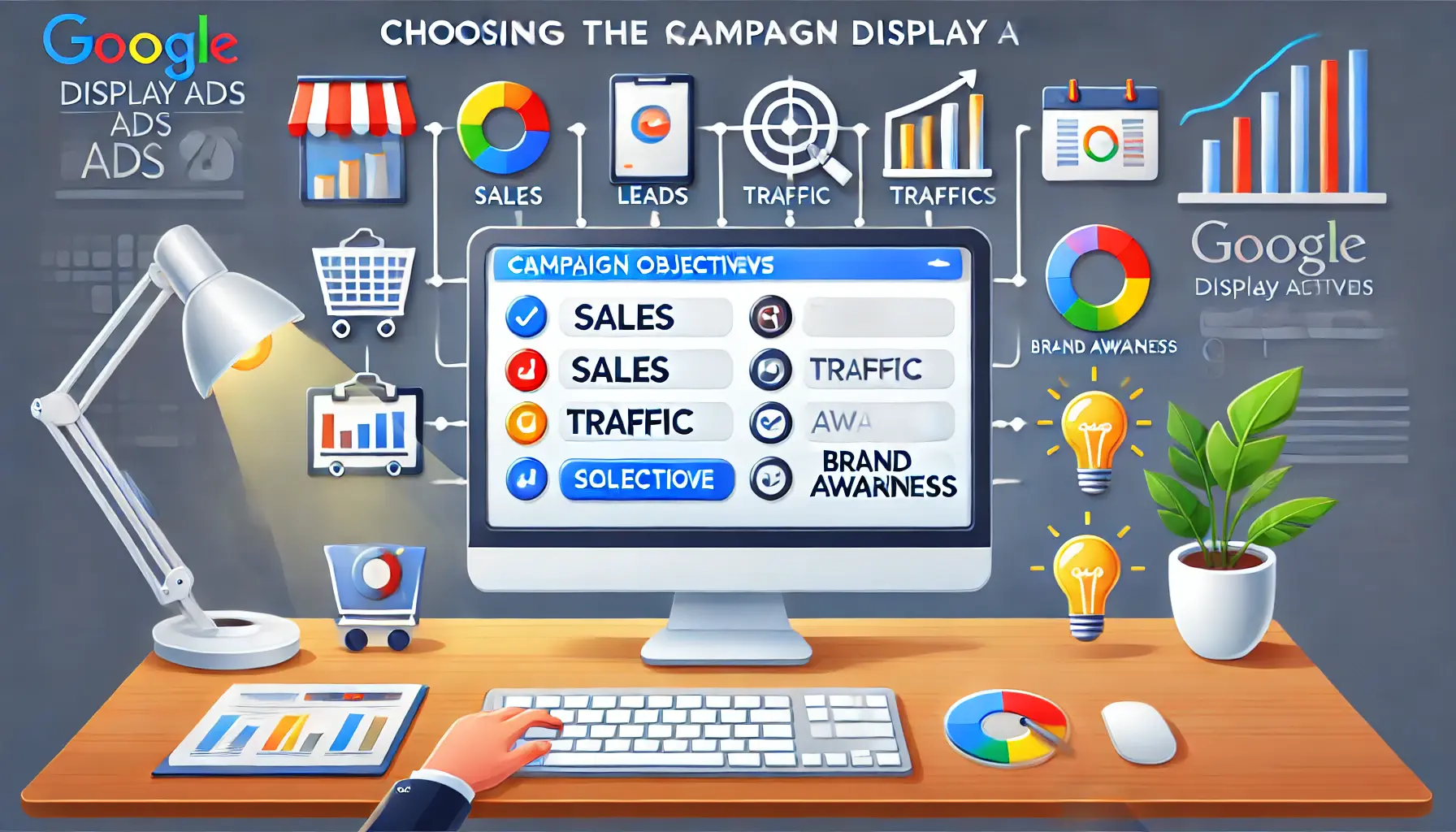
An illustration of selecting the appropriate campaign objective for a successful Google Display Ads strategy.
Choosing the Right Campaign Objective
Selecting a clear objective is crucial for guiding your campaign strategy.
Google Display Ads offer several campaign objectives, including:
- Sales: Focus on driving conversions, such as purchases or sign-ups.
- Leads: Generate interest by collecting user information for follow-up.
- Website Traffic: Drive users to your website for increased visibility.
- Brand Awareness: Increase your brand’s visibility across the Google Display Network.
Choose the objective that aligns best with your marketing goals.

An illustration of targeting the right audience to maximize the impact of Google Display Ads.
Selecting Target Audiences for Maximum Impact
Targeting the right audience is essential for maximizing the impact of your Google Display Ads.
Here’s how you can refine your audience:
- Demographics: Target users based on age, gender, income, and location.
- Interests: Use Google’s predefined audience segments to target users interested in specific topics.
- Remarketing: Re-engage users who have previously visited your website or interacted with your brand.
- Custom Intent: Create custom audiences by combining keywords and website URLs.
Effective targeting ensures your ads reach users who are most likely to engage with your brand.
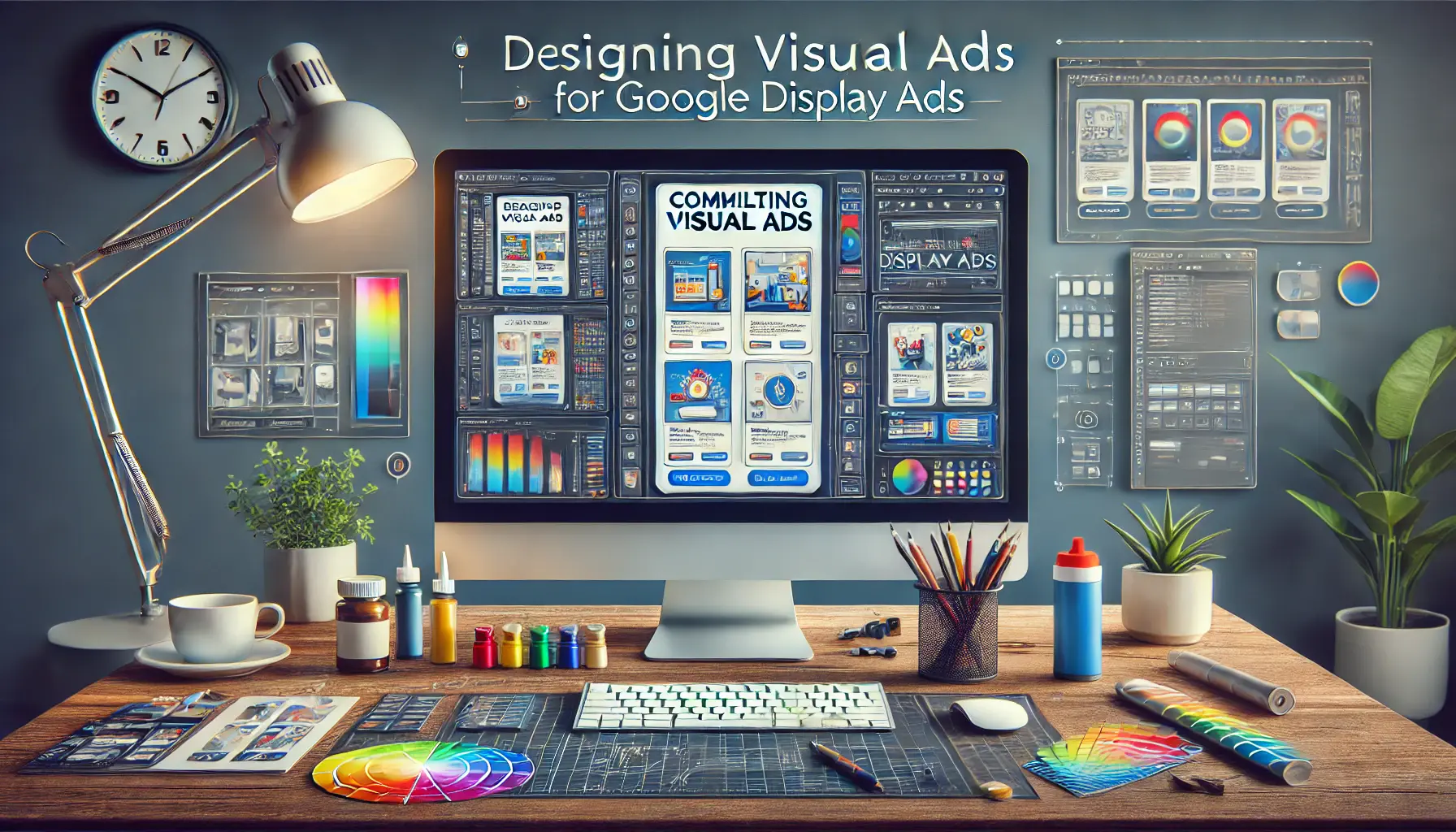
An illustration of the creative process for designing visually engaging ads for Google Display Ads.
Designing Compelling Visual Ads
Visual appeal is the cornerstone of a successful Google Display Ads campaign.
Follow these tips to create appealing ads:
- Use high-quality images and videos that represent your brand.
- Include clear messaging with a strong call-to-action (CTA).
- Ensure the ad is responsive and optimized to work well on both desktop and mobile devices.
- Follow Google’s ad creation guidelines to avoid disapproval and boost ad performance.
Well-designed ads attract users’ attention and drive action.
By setting up your Google Display Ads campaign using these steps, you’re off to a strong start in meeting your marketing goals.
The following section will provide insights into how to maximize your ROI and sustain campaign success.
Starting with clear objectives and a well-planned strategy is key to creating effective Google Display Ads campaigns.
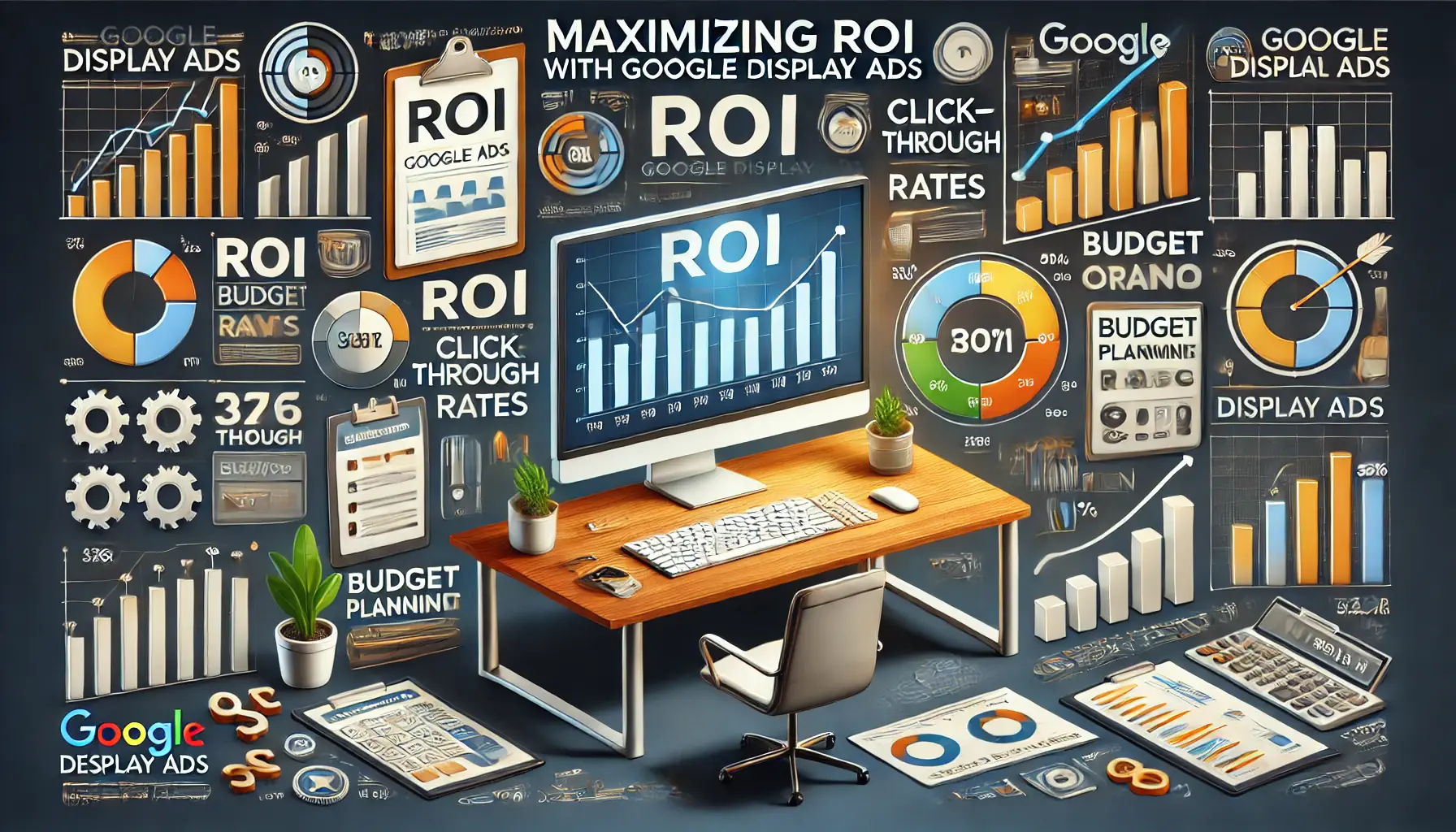
An illustration of strategies to maximize ROI using Google Display Ads through analytics and performance optimization.
How to Maximize ROI with Google Display Ads
Optimizing a Google Display Ads campaign for the best ROI is all about planning and continuous improvement.
By focusing on key performance factors, you can ensure your ads deliver value and drive measurable results.
In this section, we’ll explore effective strategies to help you maximize ROI and make the most out of your advertising budget.
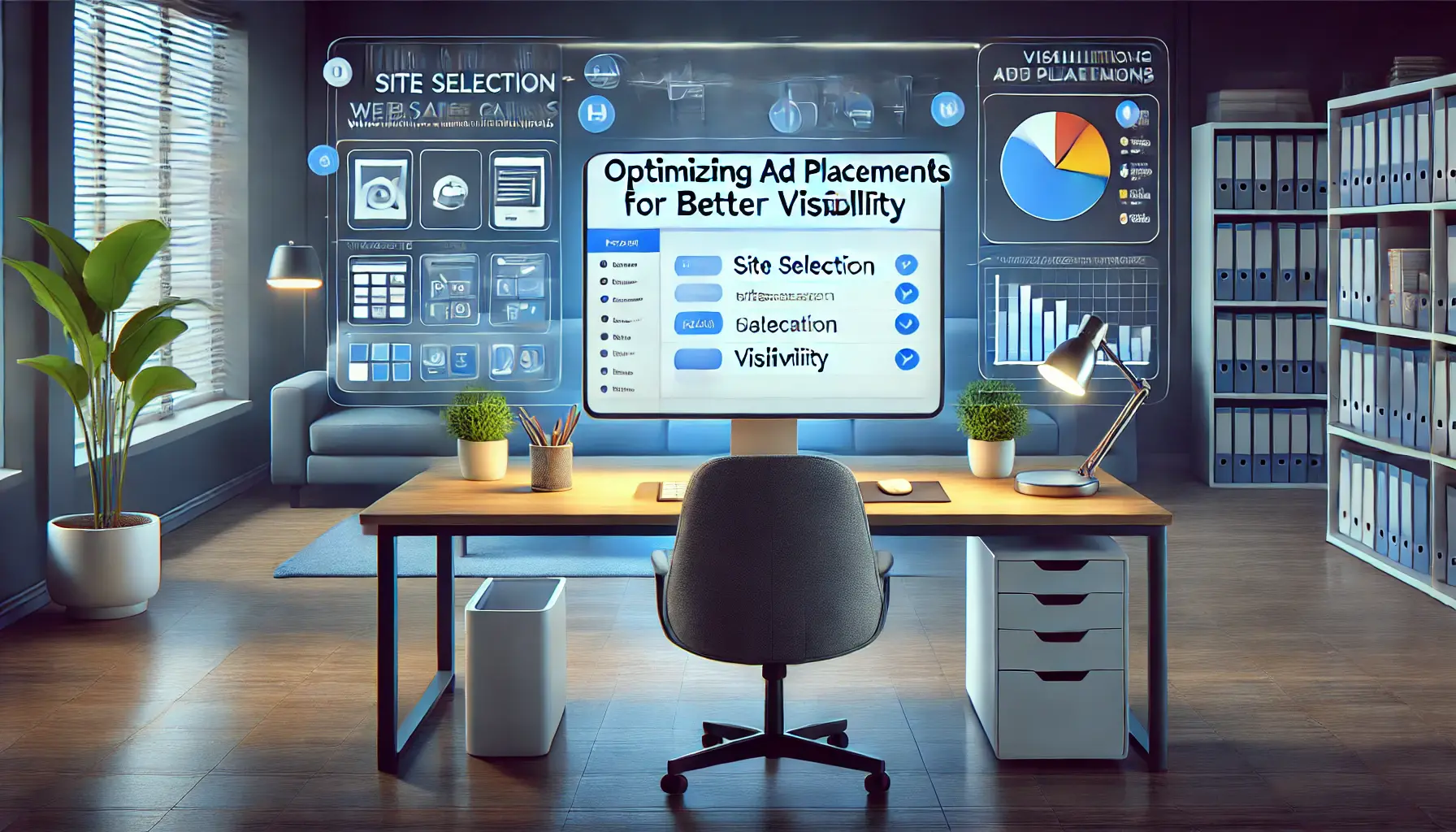
An illustration of optimizing ad placements for enhanced visibility in Google Display Ads.
Optimizing Ad Placements for Better Visibility
The placement of your ads plays a significant role in their performance.
With the Google Display Network, you can control where your ads appear by:
- Excluding Poor-Performing Placements: Regularly review your campaign’s placement report to identify websites or apps that are not delivering results and exclude them from your targeting.
- Focusing on High-Quality Sites: Use managed placements to select specific websites or categories that align with your target audience and brand goals.
- Leveraging Automated Tools: Use Google’s smart placement tools to optimize visibility without sacrificing quality.
Effective placement optimization ensures your ads are seen by the right audience in the right context.
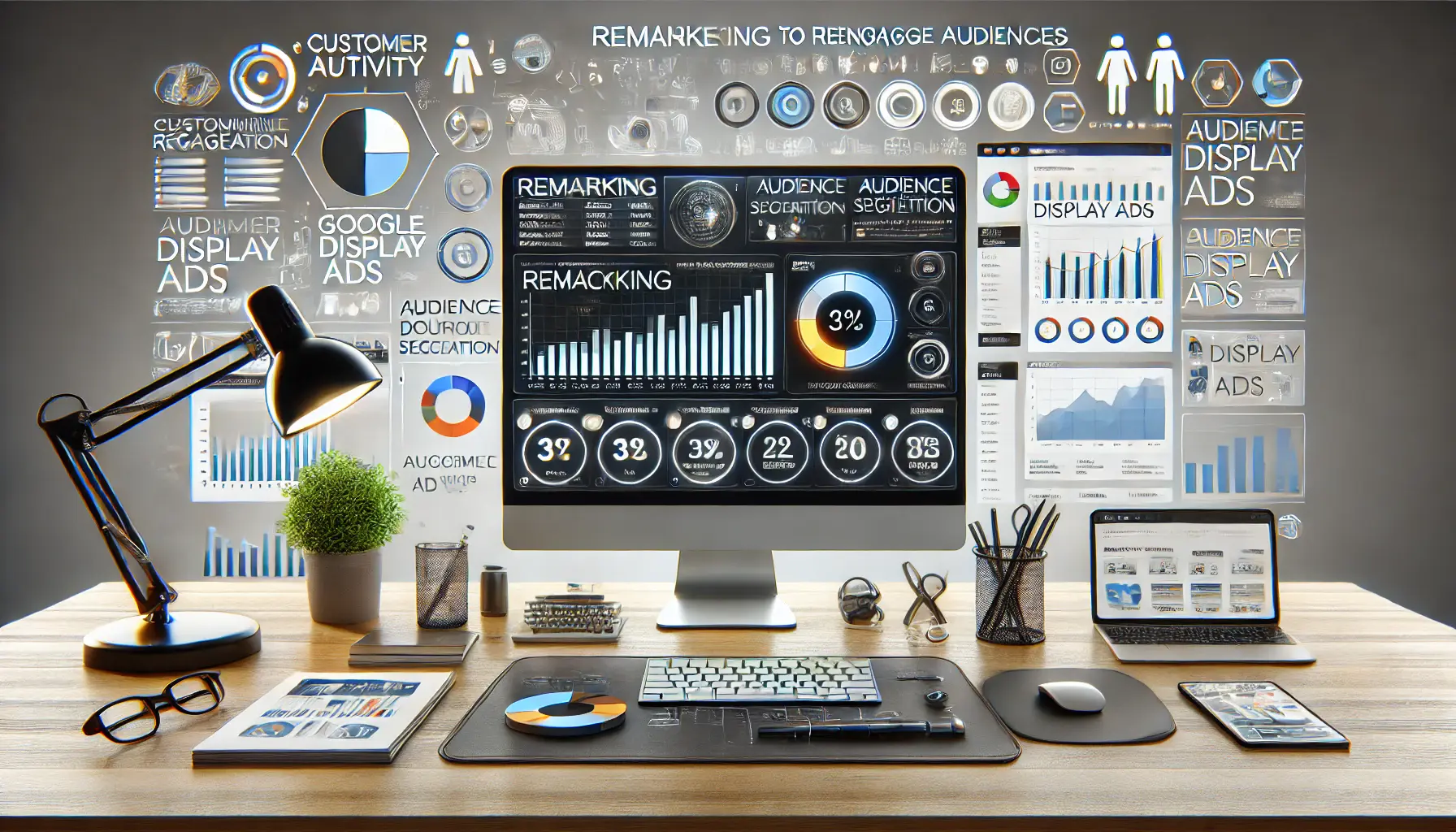
undefined
Utilizing Remarketing to Reengage Audiences
Remarketing is a powerful feature of Google Display Ads that allows you to reconnect with users who have already interacted with your brand.
Key approaches include:
- Setting up dynamic remarketing campaigns to show tailored ads based on users’ previous activity on your website.
- Using audience segmentation to target users at different stages of the customer journey, from awareness to conversion.
- Offering incentives, such as discounts or exclusive offers, to encourage repeat engagement.
Remarketing helps maintain brand visibility and encourages users to complete desired actions.
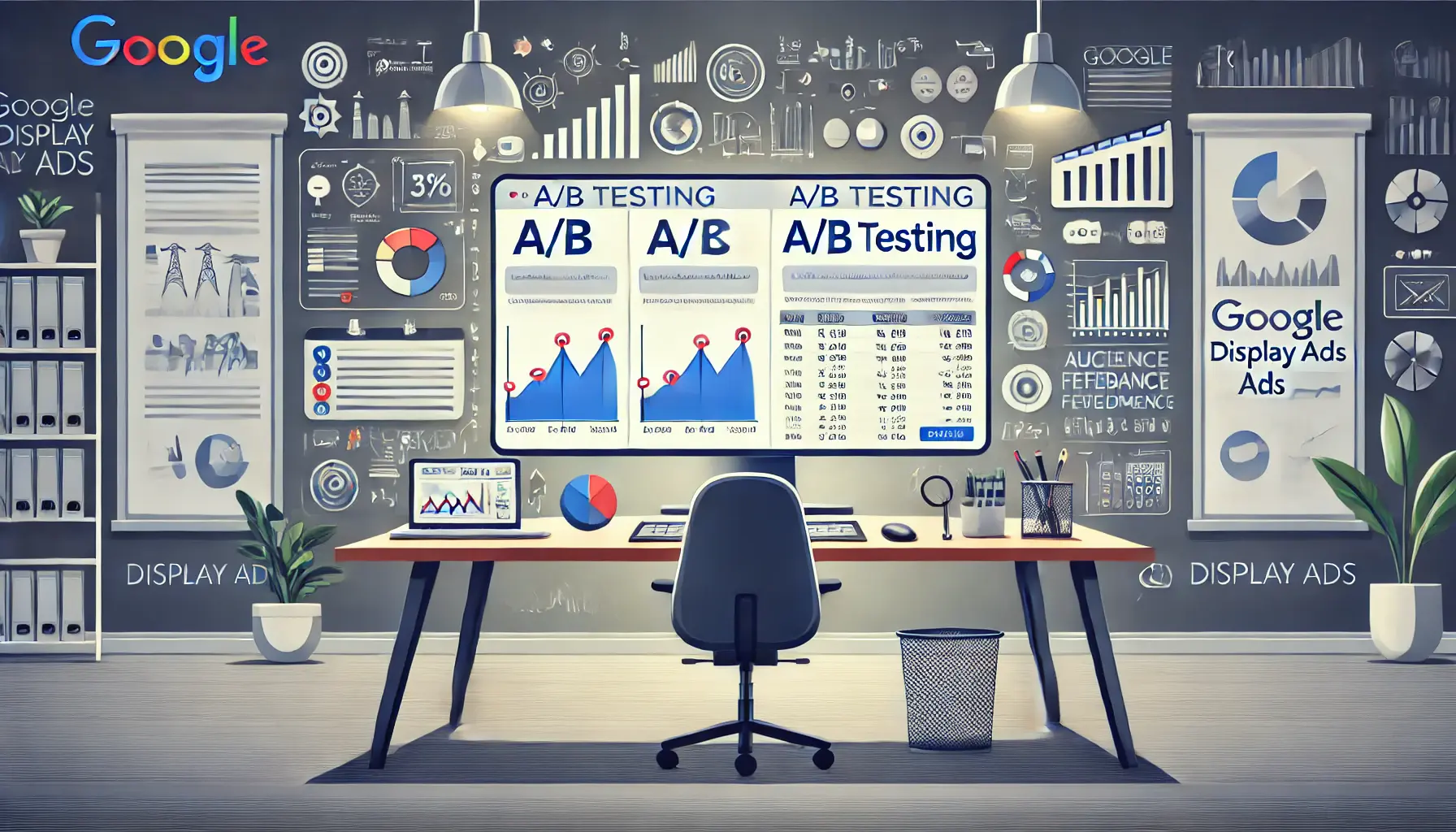
An illustration of A/B testing to enhance and optimize Google Display Ads.
A/B Testing for Continuous Improvement
Experimenting with different ad variations is essential for understanding what resonates most with your audience.
Here’s how A/B testing can enhance your campaign:
- Create multiple versions of your ad with variations in headlines, visuals, and call-to-actions.
- Test these variations on smaller audiences to identify the most effective elements.
- Use data-driven insights to refine your ad strategy and scale successful versions to a broader audience.
Regular A/B testing ensures your ads remain relevant and effective over time.
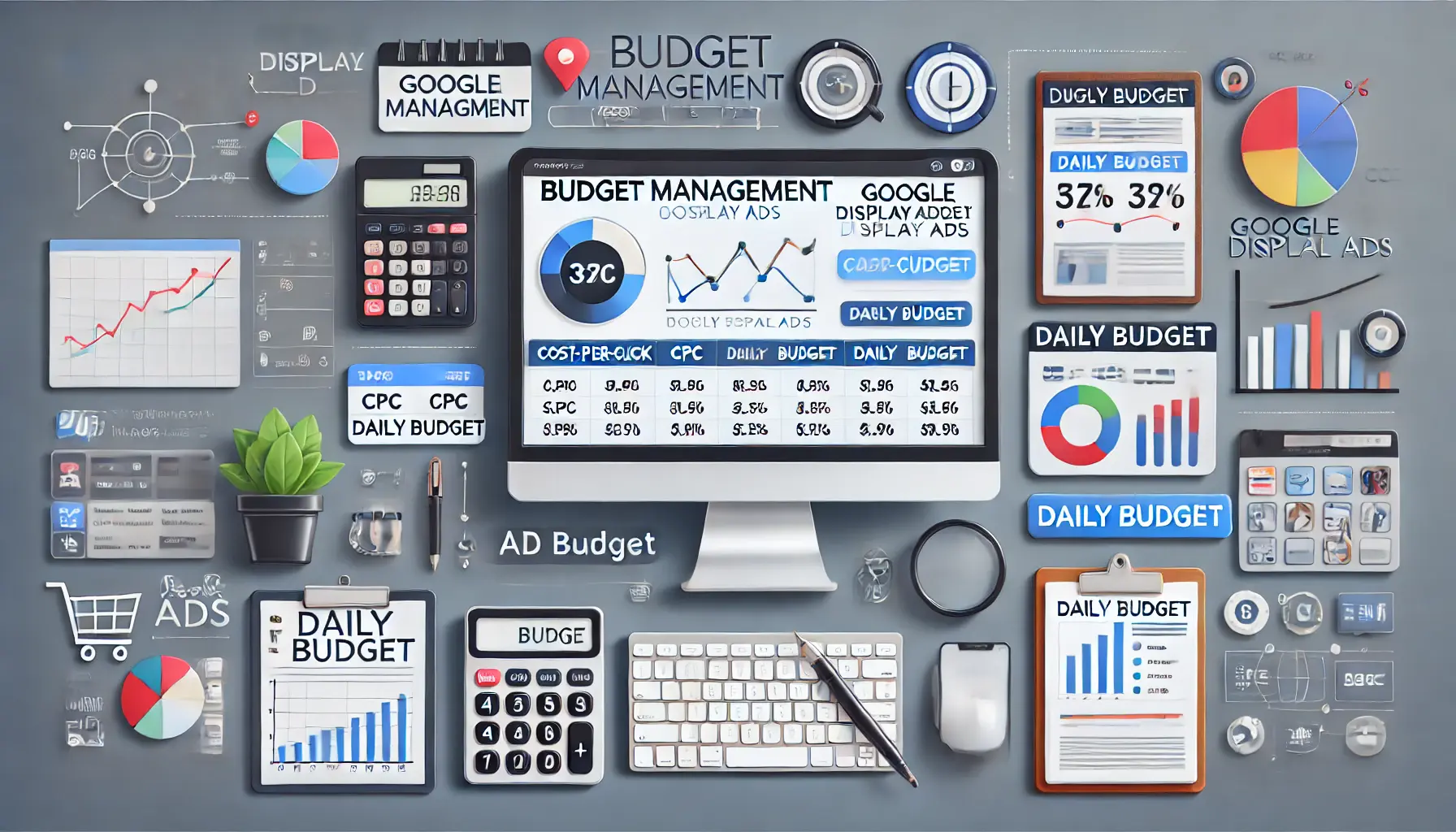
An illustration of budget management strategies for optimizing Google Display Ads spend.
Budget Management Tips for Display Ads
Proper budget management is crucial for maximizing ROI without overspending.
Consider the following tips:
- Set a daily or lifetime budget aligned with campaign objectives and financial resources.
- Use automated bidding strategies, such as Target CPA or Maximize Conversions, to optimize performance within your budget.
- Regularly observe campaign performance to identify opportunities for cost-saving adjustments.
This focused approach will help you allocate your advertising budget wisely while achieving your campaign goals.
With these strategies in place, you’re well on your way to improving the performance of your Google Display Ads campaign and achieving a positive ROI.
In the next section, we’ll discuss common mistakes to avoid when running display ad campaigns and how to address them.
Optimizing placements, leveraging remarketingA marketing strategy that targets users who have previously interacted with a brand or website., and using A/B testing are proven strategies to boost ROI.

An illustration highlighting common mistakes to avoid in Google Display Ads campaigns.
Common Mistakes to Avoid in Google Display Ads
Running a successful Google Display Ads campaign requires careful planning and execution.
However, even some of the most experienced marketers can fall into common traps that reduce campaign effectiveness.
These pitfalls present opportunities to save time and money while driving optimal results from your ads.
This section highlights the most frequent mistakes and how to address them.

An illustration of the consequences of overlooking ad frequency settings in Google Display Ads.
Overlooking Ad Frequency Settings
Ad frequency refers to how often your ads are shown to the same user.
Without proper frequency controls, users may feel bombarded by your ads, leading to ad fatigue.
To avoid this:
- Set frequency caps: Limit the number of times a user sees your ad within a specific timeframe.
- Use A/B testing: Identify the optimal frequency that maximizes engagement without overwhelming users.
- Monitor performance metrics: Adjust frequency caps as needed based on user engagement data.
Maintaining a balanced ad frequency keeps your audience engaged without creating negative impressions.

An illustration of the effects of neglecting mobile optimization in Google Display Ads.
Neglecting Mobile Optimization
With a significant portion of online traffic coming from mobile devices, neglecting mobile optimization is a critical error.
To ensure your Google Display Ads are mobile-friendly:
- Use responsive ads: Automatically adjust ad formats to fit various screen sizes and orientations.
- Test on different devices: Ensure your ads render correctly and maintain visual appeal across platforms.
- Prioritize fast-loading creatives: Provide a seamless user experience for mobile audiences.
Optimizing for mobile ensures your ads reach a broader audience and perform effectively on all devices.

An illustration of the consequences of ignoring performance metrics in Google Display Ads.
Ignoring Performance Metrics
Failing to monitor campaign performance is one of the biggest mistakes marketers make.
Without actionable insights, it is impossible to improve your campaign.
Avoid this by:
- Review key metrics regularly: Focus on click-through rates (CTR), conversions, and impressions.
- Use Google Ads reporting tools: Identify trends and areas for improvement.
- Set automated alerts: Receive notifications for significant performance changes to address issues promptly.
Tracking performance metrics allows you to make data-driven decisions that enhance campaign outcomes.

An illustration showing the impact of poorly designed creatives in Google Display Ads campaigns.
Using Poorly Designed Creatives
Low-quality or unattractive creatives can hurt your campaign’s effectiveness.
To create high-performing ad designs, follow these guidelines:
- Use clear and compelling visuals: Ensure your design reflects your brand identity and captures attention.
- Make the CTA bold and clear: Encourage users to take action with an easy-to-understand call-to-action.
- Test multiple designs: Identify which elements resonate most with your target audience.
- Follow Google’s ad guidelines: Ensure your ads meet platform standards for better performance and approval.
Investing in professional, high-quality ad design ensures your ads stand out and drive user engagement.
By addressing these common mistakes, you can significantly improve the performance of your Google Display Ads campaign.
The next section will focus on measuring and improving campaign performance to achieve sustained success.
Avoid neglecting mobile optimization, overlooking performance metrics, and using poorly designed creatives to ensure your campaign’s success.
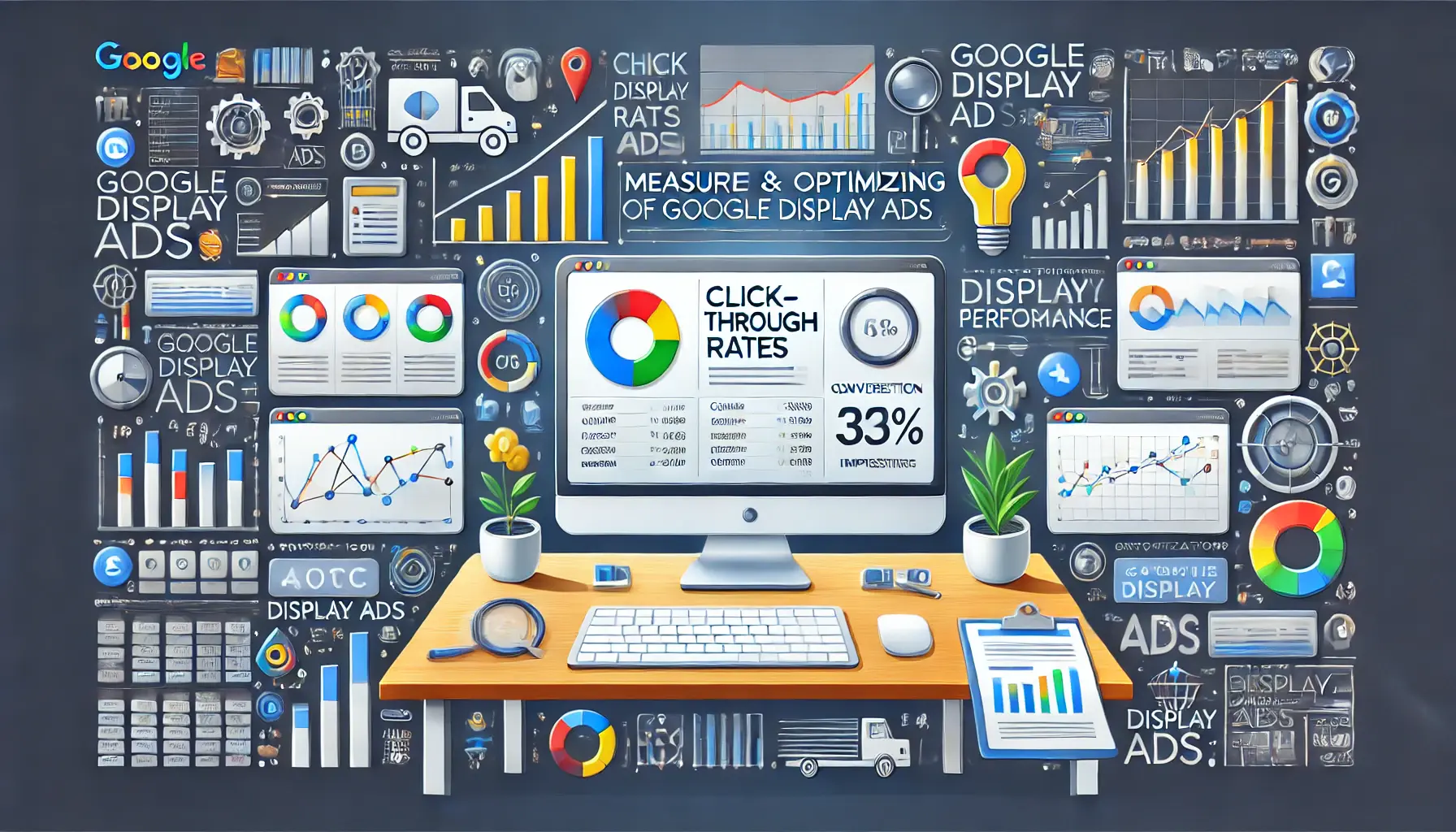
An illustration of measuring and optimizing performance for Google Display Ads through data analysis and optimization tools.
Measuring and Optimizing Performance of Google Display Ads
Effectively measuring performance is a crucial step in understanding how a campaign is performing in relation to its objectives.
By focusing on key metrics and utilizing advanced tools, you can identify areas for improvement and optimize your Google Display Ads for better results.
This section outlines the essential steps to measure and enhance your campaign performance.
An illustration of tracking key metrics with Google Analytics to optimize Google Display Ads performance.
Tracking Key Metrics with Google Analytics
Google Analytics is an indispensable tool for monitoring the performance of your Google Display Ads.
To make the most of it:
- Set up tracking: Link your Google Ads account with Google Analytics to seamlessly track ad performance.
- Monitor metrics: Focus on key performance indicators (KPIs) such as impressions, click-through rates (CTR), bounce rates, and conversions.
- Analyze user behavior: Understand how users interact with your website after clicking on your ads.
By using Google Analytics, you gain valuable insights into your audience’s behavior and campaign effectiveness.

An illustration of analyzing conversion rates and CTR to optimize Google Display Ads performance.
Analyzing Conversion Rates and Click-Through Rates
Two of the most important metrics for assessing the success of your Google Display Ads are conversion rates and click-through rates.
Here’s how to analyze them:
- Conversion Rate: Measure the percentage of users who complete desired actions, such as making a purchase or filling out a form. A higher conversion rate indicates that your ads are effectively reaching and engaging your audience.
- Click-Through Rate (CTR): Calculate the percentage of users who click on your ads out of the total impressions. A higher CTR typically reflects engaging and relevant ad content.
Regularly evaluating these metrics ensures that your campaign stays aligned with its goals.
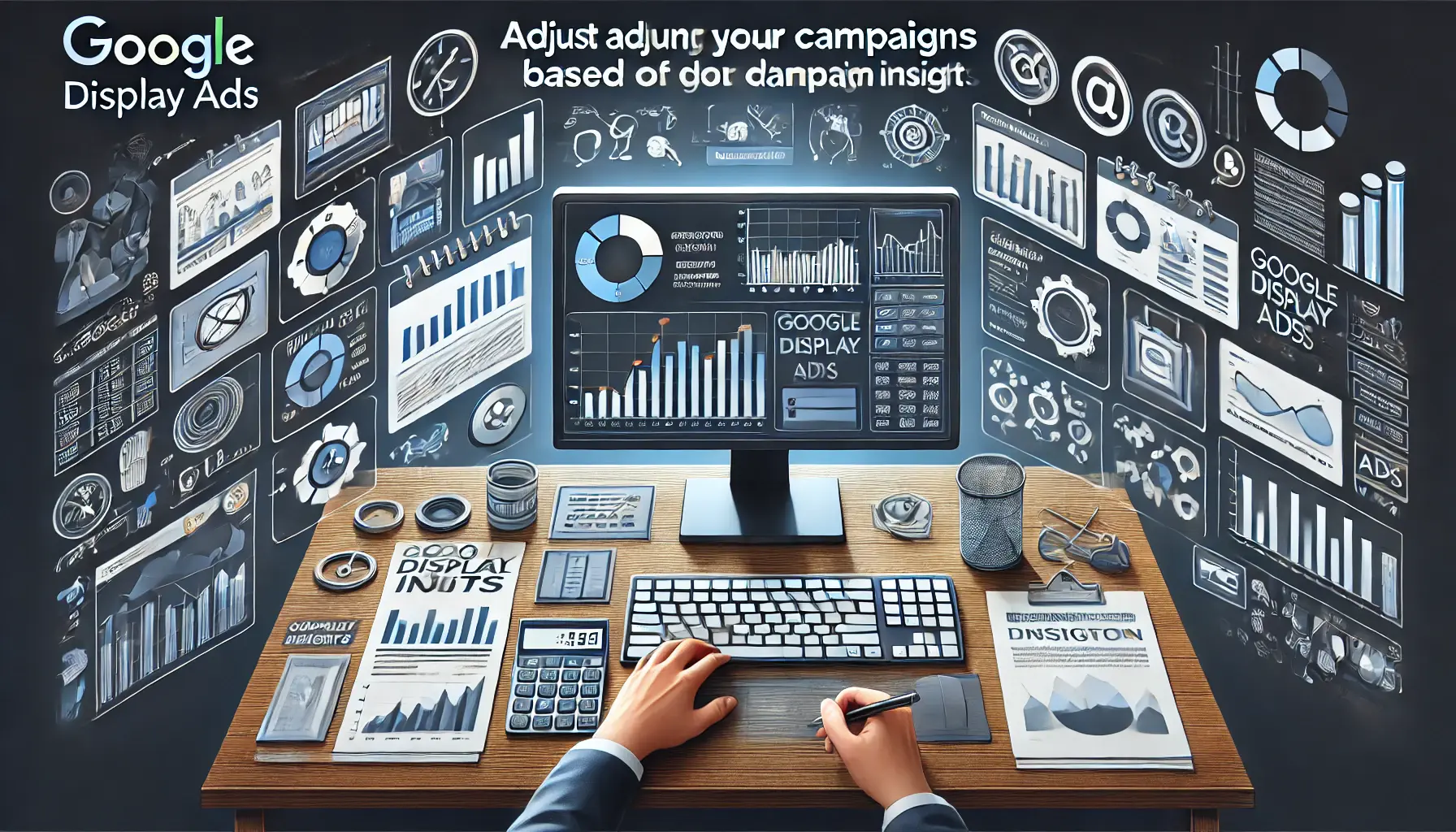
An illustration of adjusting Google Display Ads campaigns based on real-time data insights.
Adjusting Campaigns Based on Data Insights
Data-driven optimization is essential for improving the performance of your Google Display Ads.
To make informed adjustments:
- Test ad variations: Use A/B testing to determine which designs, headlines, or calls-to-action perform best.
- Refine targeting: Adjust audience demographics, interests, or remarketing parameters to focus on the most engaged users.
- Optimize bidding strategies: Experiment with bidding options, such as Target CPA or Maximize Conversions, to improve ROI.
Consistent optimization based on real-time data ensures your campaign evolves alongside audience behavior and market trends.

An illustration of staying updated with the latest Google Ads trends and technologies.
Staying Updated with Google Ads Trends
The digital advertising landscape is constantly evolving, and staying informed about trends is crucial for maintaining campaign success.
To keep your Google Display Ads competitive:
- Follow Google Ads updates: Stay informed about new features, tools, and policies introduced by Google.
- Learn from industry benchmarks: Compare your campaign performance against industry standards to identify areas for improvement.
- Leverage AI and automation: Use Google’s automated tools and machine learning capabilities to enhance ad targeting and performance.
Remaining adaptable to the latest trends ensures your campaigns remain relevant and effective in a competitive market.
By consistently measuring performance and implementing these strategies, you can maximize the effectiveness of your Google Display Ads and achieve long-term success.
Utilizing Google Analytics and regular performance tracking are essential for refining and improving campaign outcomes.
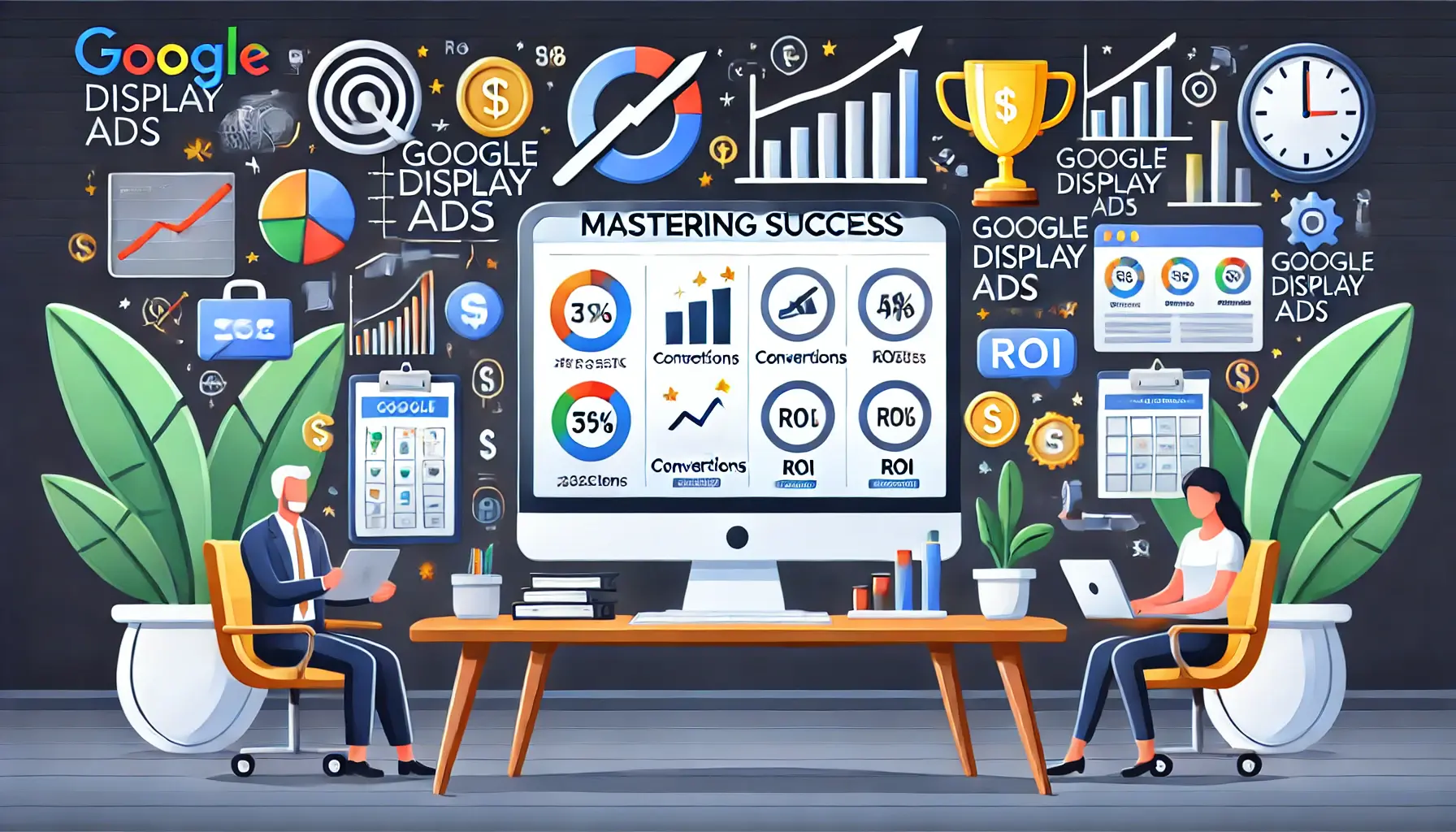
An illustration of mastering success with Google Display Ads through optimized campaigns and key performance metrics.
Mastering Success with Google Display Ads
Throughout this article, we’ve explored the ins and outs of leveraging Google Display Ads to create impactful and effective marketing campaigns.
From understanding the basics to optimizing performance, these insights provide a comprehensive guide to help you succeed in your advertising efforts.
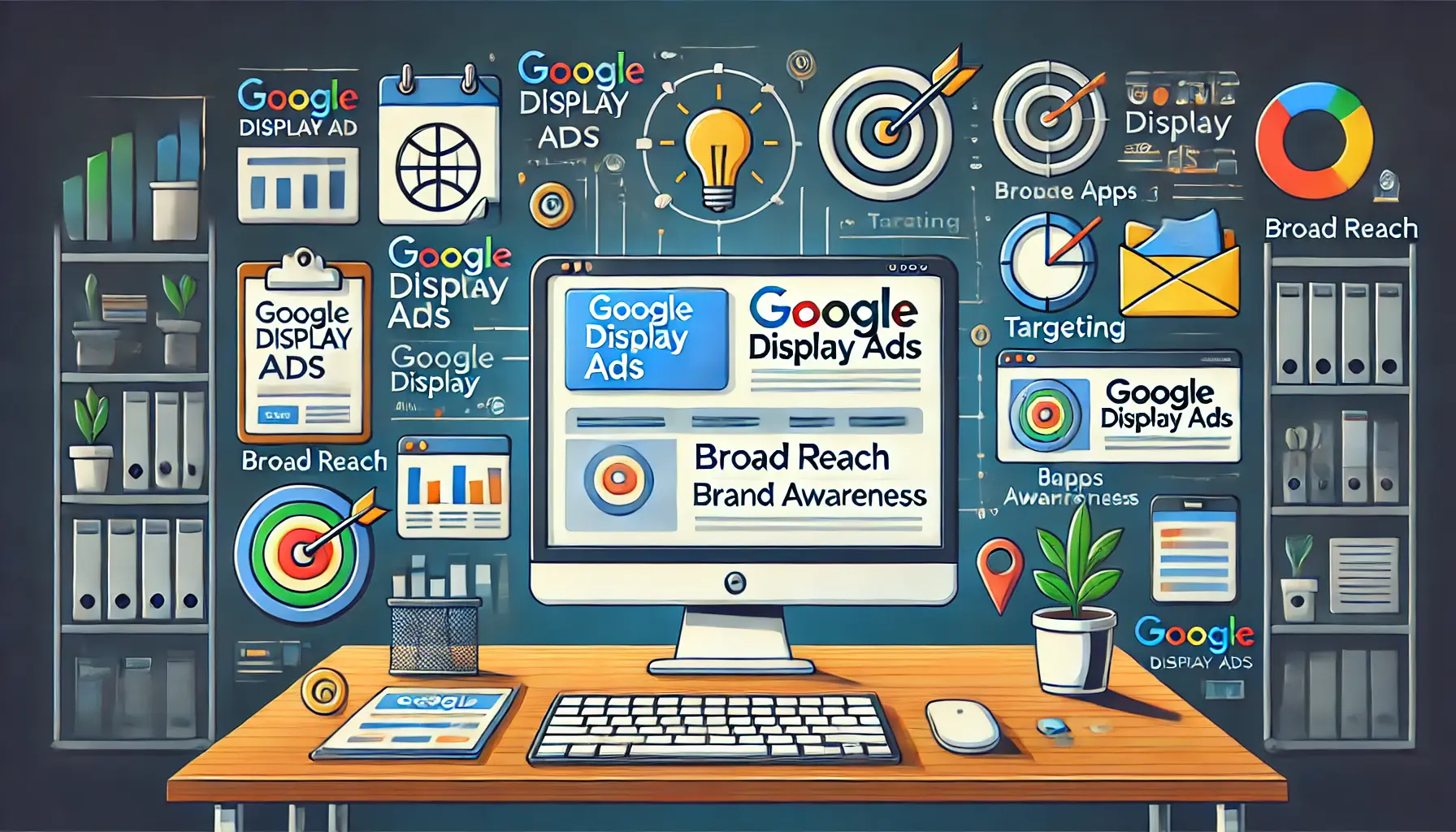
An illustration showing why Google Display Ads are essential for reaching large, diverse audiences and enhancing brand awareness.
Why Google Display Ads Are Essential
Google Display Ads empower businesses to reach a vast audience across millions of websites, apps, and videos.
Their visually engaging format allows brands to showcase products and services effectively, making them an indispensable tool in the digital marketing landscape.
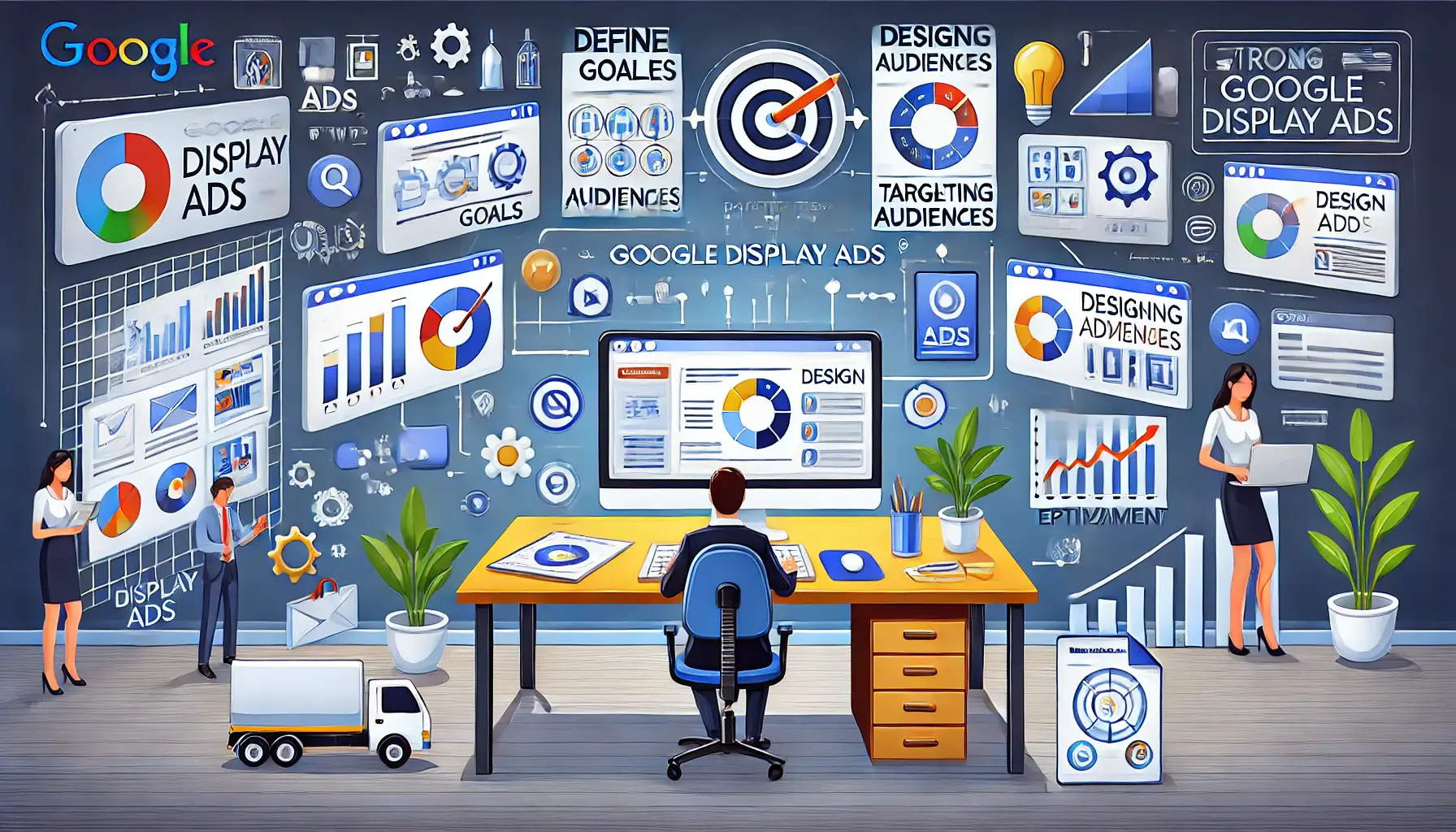
An illustration showing the key steps to build and refine a successful Google Display Ads campaign.
Steps to Build a Strong Campaign
Building a successful Google Display Ads campaign requires careful planning and execution.
The essential steps include:
- Creating a Google Ads account and setting up tracking for seamless monitoring.
- Defining clear objectives, such as increasing sales, leads, or brand awareness.
- Targeting the right audience with precision using demographic and interest-based filters.
- Designing compelling visual ads that are mobile-optimized and engaging.
These foundational practices ensure your campaign begins with a strong start.
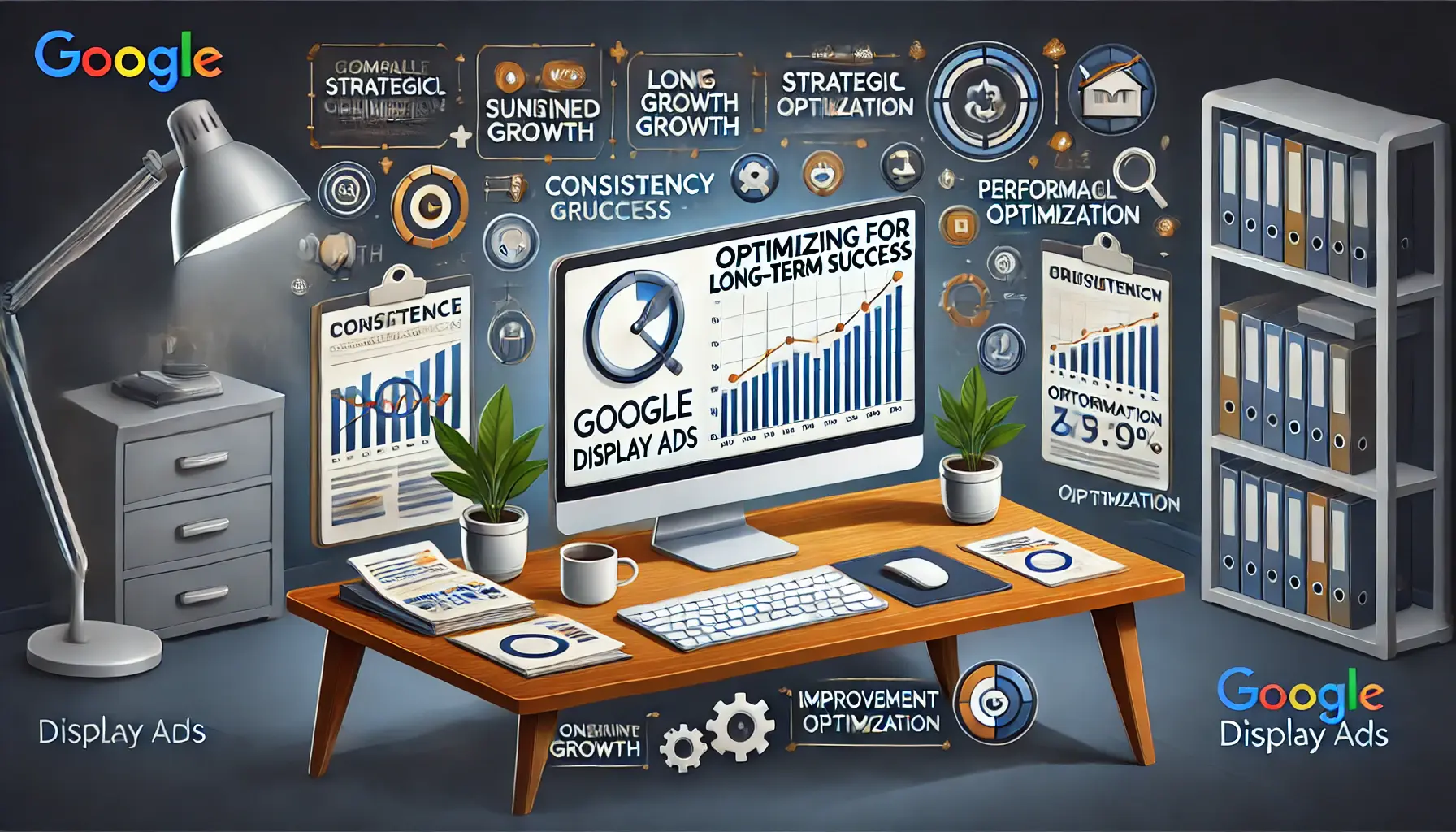
An illustration of optimizing Google Display Ads for sustained long-term success.
Optimizing for Long-Term Success
To maximize the effectiveness of your Google Display Ads, continuous optimization is key.
Strategies for success include:
- Monitoring key performance metrics, such as click-through rates (CTR) and conversion rates, using Google Analytics.
- Adjusting ad placements and frequency caps to maintain audience engagement.
- Implementing data-driven adjustments, such as refining targeting and testing ad variations.
These steps help improve your campaign’s ROI while keeping it aligned with your marketing goals.

An illustration of avoiding common pitfalls in Google Display Ads campaigns.
Avoiding Common Pitfalls
Understanding and avoiding common mistakes can save valuable resources.
These include:
- Neglecting mobile optimization, which limits your reach and engagement potential.
- Ignoring performance metrics, preventing you from making data-informed decisions.
- Using poorly designed creatives that fail to capture attention or align with your brand identity.
Being proactive in addressing these issues ensures a smoother path to success.
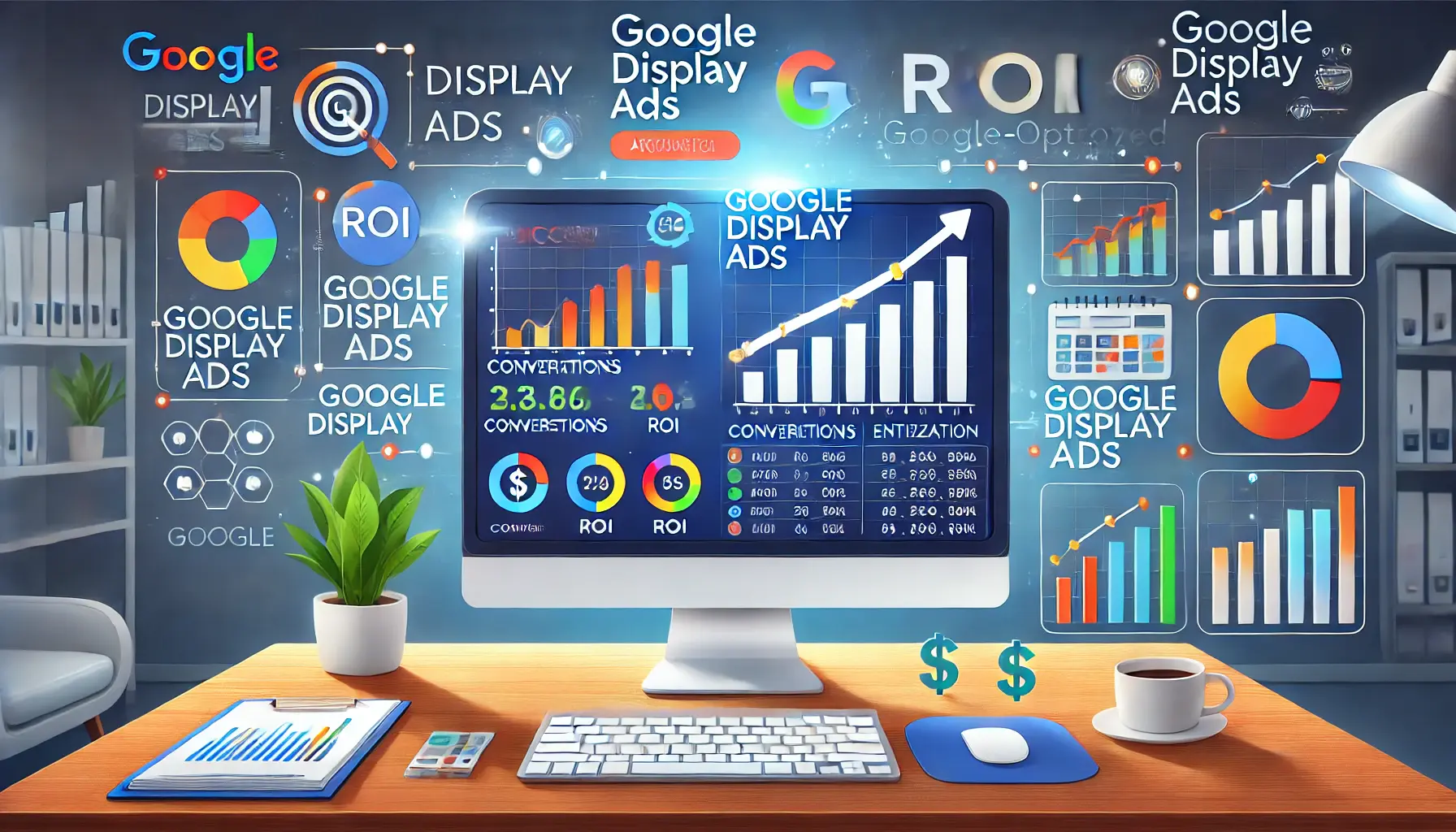
An illustration of achieving success with optimized Google Display Ads campaigns.
Achieving Success with Google Display Ads
By measuring performance, staying updated on trends, and leveraging the latest tools, your Google Display Ads campaigns can deliver exceptional results.
Long-term success in this competitive digital marketing space calls for relentless effort and attention to detail.
With this guide, you now have the tools and strategies in place to make the most of Google Display Ads for driving growth for your brand and achieving your marketing goals.
Combining foundational practices with continuous optimization ensures sustained success with Google Display Ads.
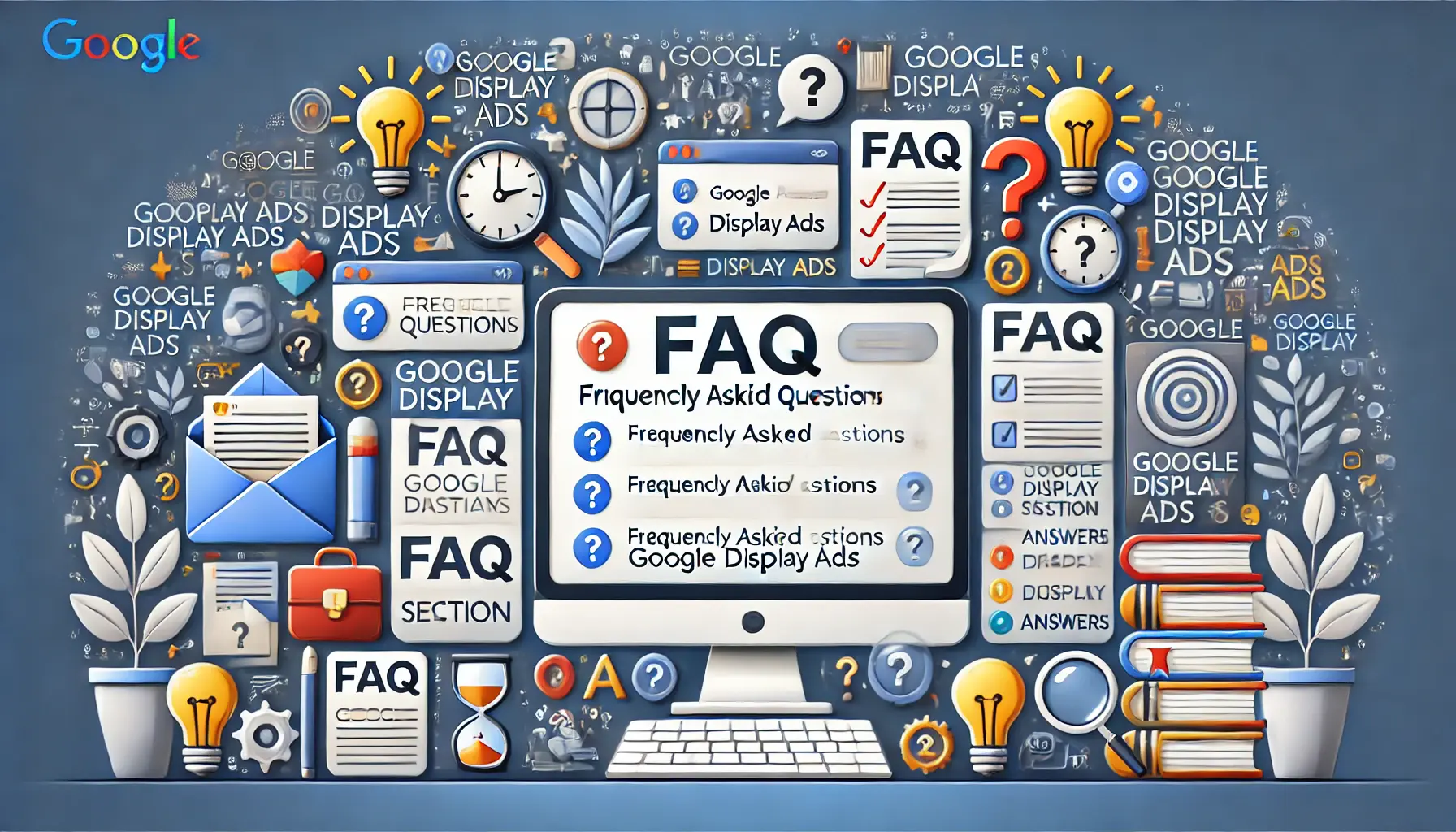
An illustration of frequently asked questions about Google Display Ads, symbolizing inquiry and answers.
Your campaigns can be managed by an agency specialized in Google Ads, check out our service page.
Frequently Asked Questions About Google Display Ads
Here are answers to some of the most common questions about Google Display Ads.
These insights will help you better understand how to leverage this advertising platform for your marketing campaigns.
Google Display Ads are visual advertisements shown across websites, apps, and videos within the Google Display Network, helping businesses reach target audiences effectively.
To set up a campaign, create a Google Ads account, select a campaign type, define objectives, target your audience, and design engaging ad creatives.
Key metrics to monitor include impressions, click-through rates (CTR), conversion rates, and bounce rates, providing insights into the effectiveness of your ads.
Display Ads focus on creating brand awareness through visuals, while Search Ads target users actively searching for specific keywords, delivering text-based results.
Benefits include broad reach, precise audience targeting, cost-effectiveness, and visually engaging formats that enhance brand awareness and drive conversions.
Yes, remarketing allows you to re-engage users who have previously interacted with your website or brand, increasing the chances of conversion.
Use frequency caps to limit ad impressions per user, refresh ad creatives regularly, and leverage A/B testing to identify the most effective formats.
Tools like Google Analytics and Google Ads reporting provide valuable data for optimizing performance through insights on audience behavior and campaign metrics.
Use responsive ads, test on various devices, and ensure fast-loading creatives to provide a seamless experience for mobile users.










